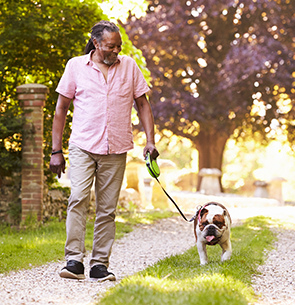Get Motivated to Get Moving

It’s not exactly breaking news: Exercise can lower your blood sugar and blood pressure, boost your energy and help you sleep better. But how do you get started when you’re in a slump?
Most of us (about 80% of Americans) don’t make exercise a regular habit. Maybe you weren’t physically active before your diagnosis, so tackling a new routine seems overwhelming.
If you want to move more but you keep finding excuses, there’s never been a better time to start a fitness habit. Your body is counting on you — and your blood sugar will thank you.
If you’ve made it this far, you’re already on the right track. Check out our recommendations for getting started.
Start small — just spend less time sitting. Consider sneaking in a little light-intensity activity. Park the car farther away at the grocery store. Take the stairs instead of the elevator. Simple steps add up.
Get stretchy. Stretching always comes first. Be sure to warm up for several minutes to get your muscles ready and then stretch slowly for at least 5 minutes before you begin. Learn these basic stretches.
Gradually work up to more activity. The goal is to get at least 150 minutes per week of moderate-intensity aerobic activity or 75 minutes per week of vigorous aerobic activity, or a combination of both. That could include activities like brisk walking, water aerobics, swimming or jogging.
Add a muscle-strengthening activity (such as resistance or weights) two days a week, increasing repetitions and intensity gradually over time.
Set your fitness goals. Write ‘em down, tell a friend, join a group on social media — whatever works to help keep you on track.
Don’t work out alone. Seek out like-minded people (virtually or in your own home) and build a new routine. This will help you make progress and keep you motivated and accountable.
Watch your numbers (and take a bow!) Keeping appointments with your health care team is important. Healthier weight, lower blood pressure, more stable blood sugar, better cholesterol numbers and improved muscle tone are all praiseworthy goals.
You also can use the results of your blood sugar checks to see how your body reacts to different activities. Understanding these patterns can help you prevent your blood sugar from going too high or too low.
The American Diabetes Association suggests that you become familiar with how your blood sugar responds to exercise. Checking your blood sugar level more often before and after exercise can help you see the benefits of activity.
Celebrate your fitness success. Whether it’s improved cholesterol or a 5-pound weight loss, reward yourself with something tangible, like an at home dance party, order new active shoes or an at home spa day.
Still convinced that the couch potato life suits you just fine? If you think you hate exercise, check out these pointers. Don’t give up, call a friend. Or better yet — meet for a walk. Who knows? You just might want to do it again tomorrow.




